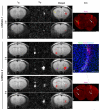Personalized nanomedicine advancements for stem cell tracking
- PMID: 22820528
- PMCID: PMC3477295
- DOI: 10.1016/j.addr.2012.07.008
Personalized nanomedicine advancements for stem cell tracking
Abstract
Recent technological developments in biomedicine have facilitated the generation of data on the anatomical, physiological and molecular level for individual patients and thus introduces opportunity for therapy to be personalized in an unprecedented fashion. Generation of patient-specific stem cells exemplifies the efforts toward this new approach. Cell-based therapy is a highly promising treatment paradigm; however, due to the lack of consistent and unbiased data about the fate of stem cells in vivo, interpretation of therapeutic effects remains challenging hampering the progress in this field. The advent of nanotechnology with a wide palette of inorganic and organic nanostructures has expanded the arsenal of methods for tracking transplanted stem cells. The diversity of nanomaterials has revolutionized personalized nanomedicine and enables individualized tailoring of stem cell labeling materials for the specific needs of each patient. The successful implementation of stem cell tracking will likely be a significant driving force that will contribute to the further development of nanotheranostics. The purpose of this review is to emphasize the role of cell tracking using currently available nanoparticles.
Copyright © 2012 Elsevier B.V. All rights reserved.
Figures







References
Publication types
MeSH terms
Grants and funding
LinkOut - more resources
Full Text Sources
Medical

